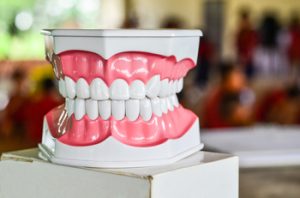When you’re missing one or more teeth, it can make speaking, eating, and even simply smiling a difficult task. The feeling of insecurity that this brings to people can be overwhelming – but the good news is there are several replacement options available to help restore your smile. Whether you need a short-term solution while waiting on a permanent fix or something more long-lasting such as dentures and bridges, we’ve got all the information you need here. Read on to find out about some great missing tooth replacement options!
1. Dental implants
Dental implants are a popular tooth replacement choice among many patients who have lost their natural teeth due to injury, gum disease, or other causes. Implants are titanium rods that are surgically placed into the jawbone to replace missing teeth.
The process involved with getting dental implants
Getting dental implants typically involves multiple steps beginning with a consultation where the dentist will evaluate the patient’s medical history to determine if they’re a good candidate for this procedure.
After this stage is complete, patients typically wait several months for the implant to fuse properly with their bone before their prosthetic teeth can be attached in place. This process takes some time, but it helps ensure that everything fits together properly so that patients have long-lasting results that look and feel natural!
The benefits of dental implants
Dental implants don’t rely on other teeth for support as traditional bridgework does. Also, unlike removable dentures, they don’t need to be removed and cleaned regularly because they are secured in place in your mouth and become part of you, just like natural teeth do. Finally, since they look and feel just like real teeth, it can be difficult to tell which ones are dental implants!
2. Dentures
Dentures are removable dental appliances that are made up of two main components; the plate (which holds the artificial teeth) and the gum-coloured base (which rests against your gums).
Types of dentures
There are several different kinds of dentures available, including partial and full dentures. Complete or full dentures are used when all the natural teeth in either the lower or upper jaw are missing. Alternatively, partial dentures replace only a few missing teeth. This type of denture is generally held in place by metal clasps that attach to adjacent teeth.
The denture process
During the denture process, impressions are taken of the patient’s mouth and jaw shape so that the dentures are customised for them, leading to optimal fit and comfort. Once crafted, the false teeth look and feel natural for the patient.
Best of all, wearing dentures takes only a few days of adjustment before one can go about using them normally. To learn more about how dentures offer a great solution to missing tooth problems, it is best to speak with your dentist today.
Benefits of dentures
Dentures can provide several benefits for those who have lost their natural teeth.
Another benefit is that modern-day dentures no longer need to be taken out every night before bedtime as they did in years past; instead, they can stay in your mouth 24 hours a day without worrying about them becoming uncomfortable or ill-fitting over time. Also, depending on what type of denture you get and how much money you want to invest, they can last anywhere from five years up to ten years before requiring refitting or replacement due to wear and tear.
3. Bridges
A bridge is an appliance that is used to replace a lost or missing tooth or teeth. It has two or more crowns that are placed on the teeth adjacent to the gap left by the missing tooth, with a false tooth in between them. The crowns on either side of the gap hold the false tooth in place and act as anchors for the bridge. Bridges can also be used to prevent remaining teeth from shifting out of place and keep other teeth from drifting into the space left by the missing tooth.
Types of bridges
Bridges come in different types, each with its own advantages and disadvantages. These include traditional bridges, resin-bonded bridges, cantilever bridges and implant-supported bridges. Traditional bridges are made up of porcelain fused with metal or ceramics, while resin-bonded bridges are made of plastic teeth supported by metal wings that attach to adjacent natural teeth. Cantilever bridges are identical to traditional bridges, but they only have one supporting crown instead of two. Implant-supported bridges use dental implants rather than adjacent natural teeth as anchors for the bridge.
What does getting a bridge involve?
The process for getting a bridge typically takes three visits over two-three weeks, depending on how complex the case is. During your initial visit, your dentist will take X-rays and impressions to determine if you’re eligible for a bridge procedure and assess whether any other treatments are necessary prior to starting treatment with a bridge. During the second appointment, your dentist will prepare the abutment teeth by removing some enamel so that crowns can fit over them securely while still leaving enough tooth structure intact so that it looks natural when finished with porcelain veneers or gold crowns if desired. During the third visit, your dentist will make sure everything fits correctly before permanently cementing the bridge into place with special cement designed specifically for dental applications that have strong bonding properties so it won’t come loose over time, as regular glue would do.
Benefits of bridges
Bridges are less expensive than implants and less time-consuming than dentures because they don’t require surgery or extensive preparation time like dentures do. They also provide better support than dentures do because they attach directly to your existing teeth and don’t need adhesives as dentures do. Additionally, dental bridges can last up to 15 years with proper care and maintenance!
4. Crowns
Crowns are artificial teeth made out of porcelain or metal that are designed to fit into the gap in your smile left by a missing tooth. They act as an anchor holding the replacement tooth in place while looking and functioning just like a real tooth. For those wanting an easier route than dentures or implants, crowns are a great suggestion.
The process of getting crowns
Getting crowns is a relatively straightforward process. First, you will need to go to your dentist and have them assess whether or not you are a good candidate for crowns. If so, they will take impressions of your mouth and create an exact mould for the crown that will fit perfectly into your mouth. Once the mould is created, it is sent off to a lab where technicians craft the custom-made crown from porcelain or metal, depending on which material you choose for your replacement tooth. The entire process usually takes about four weeks from start to finish.
Once the crown has been crafted, you will return to your dentist for one final visit, where they will check that the new crown fits snugly into place before permanently affixing it to your mouth with dental cement or adhesive paste. After this quick procedure, you’ll be ready to show off your new smile!
Benefits of using crowns
Crowns improve overall oral health by preventing damage to surrounding teeth caused by missing teeth gaps. Additionally, they look and feel just like natural teeth making them virtually indistinguishable from your real teeth once placed in your mouth!
Why should you replace a missing tooth?
Replacing a missing tooth is important for both aesthetic and functional reasons. Aesthetically speaking, replacing the missing tooth or teeth can restore your beautiful smile. On the other hand, from a functional point of view, having all teeth intact helps to ensure proper chewing, speaking and overall oral health.
No matter which option you choose for replacing missing teeth, it’s important that you speak with your dentist about the best course of action to restore your smile. With so many options available today, you’re sure to find one that works perfectly for you!
Replace your missing teeth at Casey Dentists
At Casey Dentists, we specialise in all types of tooth replacement options. Our experienced dentists can help you determine which option is best for your requirements and budget and provide you with personalised care and attention throughout the process. To learn more about our tooth replacement services or schedule an appointment, please contact us at (07) 4801 7035 today!
Note: Any surgical or invasive procedure carries risks. Before proceeding, you should seek a second opinion from an appropriately qualified health practitioner.
References
3 Teeth Replacement Options: What’s Right For You?
https://www.colgate.com/en-us/oral-health/dentures/3-teeth-replacement-options-whats-right-for-you
3 Options for Replacing Missing Teeth
https://www.healthline.com/health/dental-and-oral-health/missing-teeth


